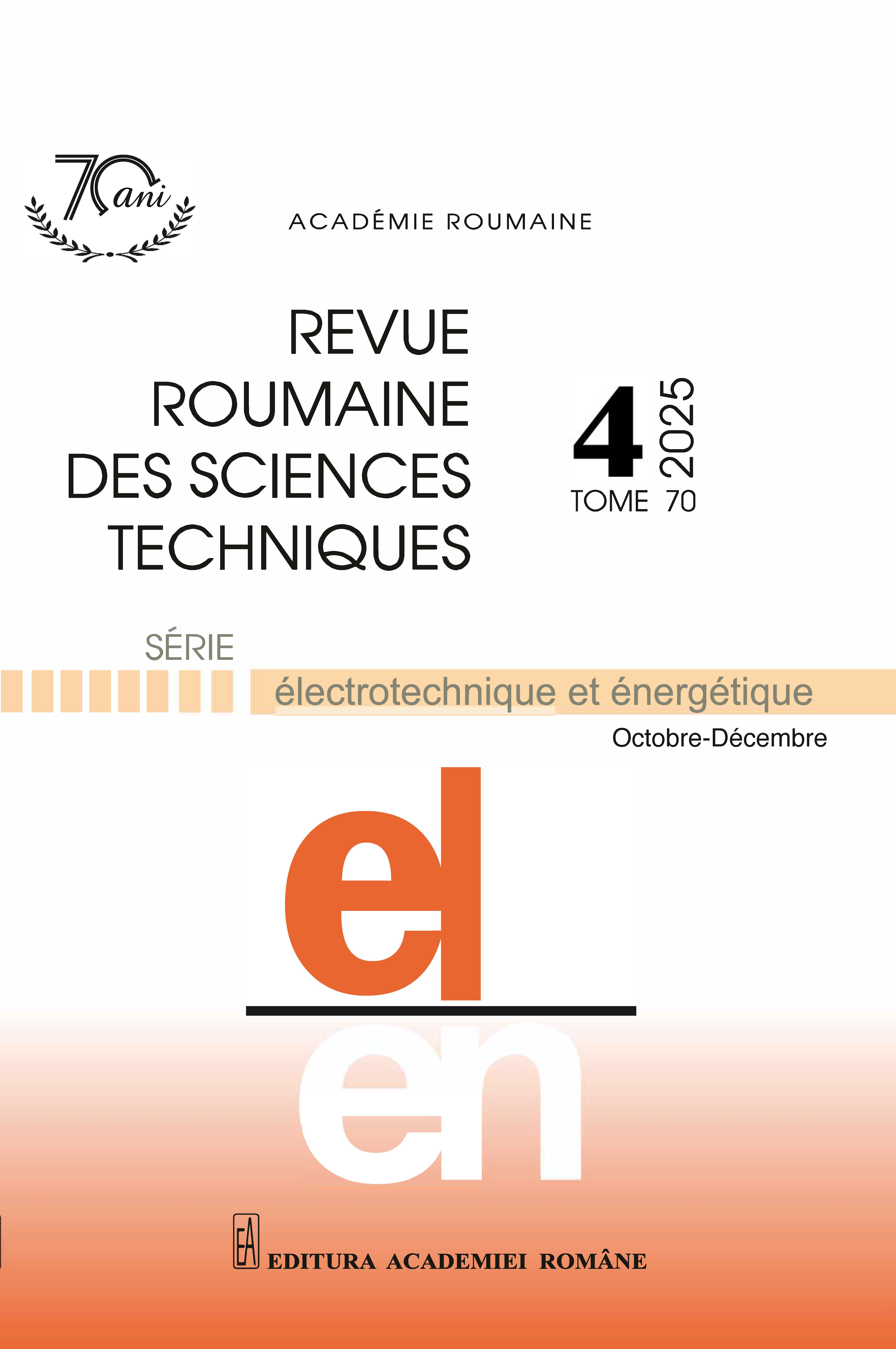FAULT DETECTION AND DIAGNOSIS IN PHOTOVOLTAIC POWER SYSTEMS USING FISHER RANDOM MATRIX APPROACH
DOI:
https://doi.org/10.59277/RRST-EE.2025.4.14Keywords:
Fault detection and diagnosis (FDD), Photovoltaic (PV) systems, Fisher random matrix theory (RMT), Real-time monitoring, Multidimensional data analysisAbstract
This paper proposes a novel methodology for fault detection and diagnosis (FDD) in photovoltaic (PV) systems that combines Fisher's linear discriminant (FLD) with the Mahalanobis distance. The approach utilizes FLD to reduce the dimensionality of operational data while maximising the separation between healthy and faulty states. The Mahalanobis distance is then used to detect anomalies by accounting for correlations among variables such as voltage, current, and temperature. The method's validity was established using real-world data from a 20 MWp PV plant in Algeria. The results obtained demonstrate the efficacy of the proposed method in classifying various faults, including open-circuit, shading, and short-circuit faults. The approach demonstrates substantial improvements in detection accuracy, efficiency, and false-alarm reduction compared to conventional methodologies. The proposed FDD solution is robust and scalable, rendering it ideal for real-time monitoring of large-scale PV systems.
References
(1) B. Gong et al., Fault diagnosis of photovoltaic array with multi-module fusion under hyperparameter optimization, Energy Conversion and Management, 319 (2024).
(2) B. Ponnuswamy, C. Columbus, S.R. Lakshmi, and J. Chithambaram, Wind turbine fault modeling and classification using cuckoo-optimized modular neural networks, Rev. Roum. Sci. Techn. – Électrotechn. et Énerg., 68, 4, pp. 369–374 (2023).
(3) C. Saiprakash et al., Improved fault detection and classification in PV arrays using Stockwell transform and data mining techniques, Results in Engineering, 23 (2024).
(4) K. Ding et al., Feature extraction and fault diagnosis of photovoltaic array based on current–voltage conversion, Applied Energy, 353 (2024).
(5) F. Harrou, A. Saidi, Y. Sun, and S. Khadraoui, Monitoring of Photovoltaic Systems Using Improved Kernel-Based Learning Schemes, IEEE Journal of Photovoltaics, 11, 3, pp. 806–818 (2021).
(6) E.Q.J. M. and V. Subramanian, Strategic load flow assessment for a ship microgrid with photovoltaic power integration, Rev. Roum. Sci. Techn. – Électrotechn. et Énerg., 70, 3, pp. 397–402 (2025).
(7) A. Saidi, B. Cherif, and B. Chellali, Fuzzy intelligent control for solar/wind hybrid renewable power system, EEA - Electrotehnica, Electronica, Automatica, 65, 4 (2017).
(8) R. Tang et al., Fault classification of photovoltaic module infrared images based on transfer learning and interpretable convolutional neural network, Solar Energy, 276 (2024).
(9) Z. Hu et al., Improved multistep ahead photovoltaic power prediction model based on LSTM and self-attention with weather forecast data, Applied Energy, 359 (2024).
(10) M. Jalal et al., Deep learning approaches for visual faults diagnosis of photovoltaic systems: State-of-the-Art review, Results in Engineering, 23 (2024).
(11) A. Keddouda et al., Photovoltaic module temperature prediction using various machine learning algorithms: Performance evaluation, Applied Energy, 363 (2024).
(12) D. Li et al., Sensing anomaly of photovoltaic systems with sequential conditional variational autoencoder, Applied Energy, 353 (2024).
(13) Q. Qi et al., Development assessment of regional rooftop photovoltaics based on remote sensing and deep learning, Applied Energy, 375 (2024).
(14) T. Peng et al., An integrated framework of Bi-directional long-short term memory (BiLSTM) based on sine cosine algorithm for hourly solar radiation forecasting, Energy, 221 (2021).
(15) J. Zhang et al., Fast object detection of anomaly photovoltaic (PV) cells using deep neural networks, Applied Energy, 372 (2024).
(16) H. Wang et al., Multi-prediction of electric load and photovoltaic solar power in grid-connected photovoltaic system using state transition method, Applied Energy, 353 (2024).
(17) E.A. Ramadan et al., An innovative transformer neural network for fault detection and classification for photovoltaic modules, Energy Conversion and Management, 314 (2024).
(18) M.F. Tahir et al., Enhancing PV power forecasting with deep learning and optimizing solar PV project performance with economic viability: A multi-case analysis of 10 MW Masdar project in UAE, Energy Conversion and Management, 311 (2024).
(19) A. Słowik et al., An efficient approach to parameter extraction of photovoltaic cell models using a new population-based algorithm, Applied Energy, 364 (2024).
(20) L.-A. Mustaţǎ, G.-D. Sorea, and E. Helerea, Monitoring and control software for a standalone house supply system, Rev. Roum. Sci. Techn. – Électrotechn. et Énerg., 70, 2, pp. 169–174 (2025).
(21) E.Q.J. M. and V. Subramanian, Strategic load flow assessment for a ship microgrid with photovoltaic power integration, Rev. Roum. Sci. Techn. – Électrotechn. et Énerg., 70, 3, pp. 397–402 (2025).
(22) L. Khettache, M.R. Rezoug, A. Saadi, and L. Sahraoui, A novel design of a photovoltaic system based on a linear induction motor and a reciprocating pump, Rev. Roum. Sci. Techn. – Électrotechn. et Énerg., 70, 1, pp. 3–8 (2025).
Downloads
Published
Issue
Section
License
Copyright (c) 2025 REVUE ROUMAINE DES SCIENCES TECHNIQUES — SÉRIE ÉLECTROTECHNIQUE ET ÉNERGÉTIQUE

This work is licensed under a Creative Commons Attribution-NonCommercial-NoDerivatives 4.0 International License.


